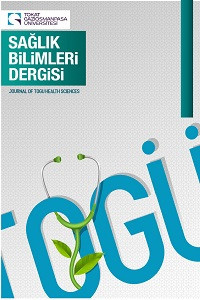COVID-19 PANDEMİSİ SIRASINDA BEL AĞRISI OLAN HASTALARDA AĞRI ŞİDDETİNİN BELİRLEYİCİLERİ
Covid-19, Bel ağrısı, Ağrı şiddeti, Fiziksel aktivite
THE PREDICTORS OF PAIN INTENSITY IN THE PATIENTS WITH LOW BACK PAIN DURING THE COVID-19 PANDEMIC
Covid-19, Low back pain, Pain intensity, Physical activity,
___
- 1. Grabovac I, Dorner TE. Association between low back pain and various everyday performances : Activities of daily living, ability to work and sexual function. Wien Klin Wochenschr. 2019;131(21-22):541-9.
- 2. Hartvigsen J, Hancock MJ, Kongsted A, Louw Q, Ferreira ML, Genevay S, et al. What low back pain is and why we need to pay attention. Lancet. 2018;391(10137):2356-67.
- 3. Hill JC, Fritz JM. Psychosocial influences on low back pain, disability, and response to treatment. Phys Ther. 2011;91(5):712-21.
- 4. Crettaz B, Marziniak M, Willeke P, Young P, Hellhammer D, Stumpf A, et al. Stress-induced allodynia--evidence of increased pain sensitivity in healthy humans and patients with chronic pain after experimentally induced psychosocial stress. PLoS One. 2013;8(8):e69460.
- 5. Shanthanna H, Strand NH, Provenzano DA, Lobo CA, Eldabe S, Bhatia A, et al. Caring for patients with pain during the COVID-19 pandemic: consensus recommendations from an international expert panel. Anaesthesia. 2020;75(7):935-44.
- 6. Bekele F, Sheleme T, Fekadu G, Bekele K. Patterns and associated factors of COVID-19 knowledge, attitude, and practice among general population and health care workers: A systematic review. SAGE Open Med. 2020;8:2050312120970721.
- 7. Cucinotta D, Vanelli M. WHO Declares COVID-19 a Pandemic. Acta Biomed. 2020;91(1):157-60.
- 8. Deer TR, Sayed D, Pope JE, Chakravarthy KV, Petersen E, Moeschler SM, et al. Emergence From the COVID-19 Pandemic and the Care of Chronic Pain: Guidance for the Interventionalist. Anesth Analg. 2020;131(2):387-94.
- 9. Clauw DJ, Häuser W, Cohen SP, Fitzcharles MA. Considering the potential for an increase in chronic pain after the COVID-19 pandemic. Pain. 2020;161(8):1694-7.
- 10. Javed S, Hung J, Huh BK. Impact of COVID-19 on chronic pain patients: a pain physician's perspective. Pain Manag. 2020;10(5):275-7.
- 11. Marchant G, Bonaiuto F, Bonaiuto M, Guillet Descas E. Exercise and Physical Activity eHealth in COVID-19 Pandemic: A Cross-Sectional Study of Effects on Motivations, Behavior Change Mechanisms, and Behavior. Front Psychol. 2021;12:618362.
- 12. Alsufiany MB, Lohman EB, Daher NS, Gang GR, Shallan AI, Jaber HM. Non-specific chronic low back pain and physical activity: A comparison of postural control and hip muscle isometric strength: A cross-sectional study. Medicine (Baltimore). 2020;99(5):e18544.
- 13. McCormack HM, Horne DJ, Sheather S. Clinical applications of visual analogue scales: a critical review. Psychol Med. 1988;18(4):1007-19.
- 14. Inal-Ince D, Savci S, Saglam M, Arikan H, Calik E, Vardar-Yagli N, et al. Predictors of physical inactivity in elderly patients with chronic obstructive pulmonary disease. International Journal of Gerontology. 2014;8(4):193-6.
- 15. Romero-Blanco C, Rodríguez-Almagro J, Onieva-Zafra MD, Parra-Fernández ML, Prado-Laguna MDC, Hernández-Martínez A. Physical Activity and Sedentary Lifestyle in University Students: Changes during Confinement Due to the COVID-19 Pandemic. Int J Environ Res Public Health. 2020;17(18).
- 16. Lesser IA, Nienhuis CP. The Impact of COVID-19 on Physical Activity Behavior and Well-Being of Canadians. Int J Environ Res Public Health. 2020;17(11).
- 17. Teichtahl AJ, Urquhart DM, Wang Y, Wluka AE, O'Sullivan R, Jones G, et al. Physical inactivity is associated with narrower lumbar intervertebral discs, high fat content of paraspinal muscles and low back pain and disability. Arthritis Res Ther. 2015;17(1):114.
- 18. Bontrup C, Taylor WR, Fliesser M, Visscher R, Green T, Wippert PM, et al. Low back pain and its relationship with sitting behaviour among sedentary office workers. Appl Ergon. 2019;81:102894.
- 19. Holth HS, Werpen HK, Zwart JA, Hagen K. Physical inactivity is associated with chronic musculoskeletal complaints 11 years later: results from the Nord-Trøndelag Health Study. BMC Musculoskelet Disord. 2008;9:159.
- Yayın Aralığı: Yılda 3 Sayı
- Başlangıç: 2021
- Yayıncı: Tokat Gaziosmanpaşa Üniversitesi
KÜLTÜRLERARASI BİR ÖLÇEK UYARLAMA ÇALIŞMASI; NORMAL DOĞUMA YÖNELİK ÖZ-YETERLİLİK ÖLÇEĞİ
Ayşenur KAHRAMAN, Özgür ALPARSLAN
PANDEMİ SÜRECİNDE SAĞLIK ÇALIŞANLARININ ŞİDDET EĞİLİMİNİN İNCELENMESİ
Zümrüt YILAR ERKEK, Serap GÖKÇEK
COVID-19 PANDEMİSİ SIRASINDA BEL AĞRISI OLAN HASTALARDA AĞRI ŞİDDETİNİN BELİRLEYİCİLERİ
Hayriye YILMAZ, Gülşah ÖZSOY, İsmail ÖZSOY
Çocuklarda İnek Sütü Proteini Alerjisi
Döndü ŞANLITÜRK, Çiğdem ERDOĞAN
Ali SERT, Serkan KÖKSOY, Mümin POLAT
DEMANSA KARŞI KORUMADA BESLENMENİN ETKİSİ: NÖRODEJENERATİF GECİKME MÜDAHALESİ DİYETİ
Deran DALBUDAK SANSAR, Aylin SEYLAM KÜŞÜMLER
Pandemi Döneminde Ebelik Bölümü Öğrencisi Olmak: Nitel Bir Araştırma
Özlem DOĞAN YÜKSEKOL, Mihriban ULUCAN, Nazlı BALTACI, Münevver Aybüke BERBER
